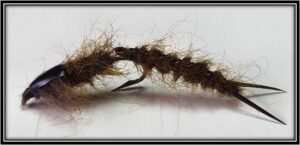April Fly of the Month
Paul’s Hairy Hellge
Paul Gausman, BRSC member, – Somerset, WI
The hellgrammite (dobsonfly larvae) is the Tyrannosaurus of the aquatic world. It thrives in the cold clean waters of the Brule River. I was inspired to tie this fly back in the 1980s when my friend, Dean Wellman, told me that his dad was catching steelhead on a rubber cast version of a hellgrammite. Not many companies offered them for sale back then, but the market is flooded with them now. I decided to try tying a couple wiggle-nymph style hellgrammites that would be very hairy and buggy looking and would be about 2 to 2½ inches long.
There were steelhead in the river when I decided to test this fly. I slipped the canoe in for a solo float to try it in some deep gravel runs. On the first drift, I was just getting my presentation set up when the rod bent in half and was almost jerked out of my hand. It was obviously a very heavy fish and caught me off guard. It made a run under the alders and was gone. I was impressed more by how far the fish moved to take the fly than how hard the take was!
I tie this fly unweighted and dead drift it on a mono rig. As nymph fisherman know, sometimes the takes can be a subtle stop. Fish it with your system of choice. You can weight the fly with your preferred method. Be on your toes. You just never know when you might get “freight-trained” as I did.
Abdomen recipe
- Hook: Any straight-eyed 4xls with a shank that is ~1¼ inches in length (straighten the bend if needed to get the length).
- Thread: Brown Danville 140 Flymaster Plus.
- Tail: Brown goose biots. Attach the thread in the middle of the shank and wrap to about 1/8th inch of the bend, leaving an area to cut the bend off when completed. Make a small dubbing ball of brown olive goat to help separate the two goose biots. Tie in 2 biots so that the curved sides face each other
- Rib: Attach a 4- or 5-inch piece of brown 4-strand floss. For step 6.
- Abdomen: Brown-olive African goat or Angora goat dubbing. Dub the abdomen to the hook eye with a gradual increase in the taper.
- Rib: Twist the 4-strand floss tight and wrap forward to make the ribs. Space each rib slightly farther apart to make increasingly wider segments. Tie off and whip finish. Put a dab of super glue behind the dubbing ball that separates the goose biots in the tail before removing the abdomen from the vise and cutting the bend off the hook shank.
Thorax recipe
- Hook: Mustad 3906B or equivalent – size 6.
- Connection loop: 12 lb. test Maxima Chameleon monofilament. Thread the mono through the eye on the abdomen, making a loop back to the thorax hook. Secure the loop to the hook using thread wraps while leaving the loop a little loose so that the abdomen can wiggle around. Cement the line on the shank with the super glue.
- Wing case: Brown Wapsi Thin Skin. Attach a piece that is about 3/16 of an inch wide at the halfway position on the hook shank. This piece is used in step 5.
- Body: Brown-olive African goat or Angora goat dubbing. Dub the body with a taper matching the abdomen. Don’t be afraid to use some super glue here to help build up the dubbing to match the taper. You don’t want this to come unraveled as this is the business end of the fly.
- Wing case: Pull the wing case forward once you’re satisfied with the taper. Tie off the wing case off, making a nice head. Brush out the hair to the sides and add a little more super glue. Lastly, trim the bottom to make a flatter appearance.
To see our past patterns, click on Past patterns.
